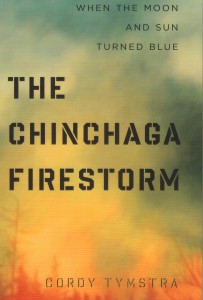On September 26, 1950 the sun turned deep blue over Edinburgh. The phenomenon was so unnerving Scottish motorists pulled over to gape at the indigo light. U.S. President Truman had announced hydrogen bomb testing earlier that year; no one could be sure what the Soviets were up to. If atomic scientists unleashed the end of time, it was bound to change the colour of the sun.
The cause was not a physics experiment gone awry, but a forest fire in northwest Alberta – the Chinchaga Firestorm of 1950. It might rate among the great fires of all time but for its location. Unlike the 1666 Fire of London or the blaze that razed Chicago in 1871, the Chinchaga fire raged far from any major city and merely captivated eyewitnesses over half the globe.
Firestorm is an intriguing account of the largest forest fire in Canadian history. Author Cordy Tymstra is a Government of Alberta wildfire science coordinator; contributor Professor Mike Flannigan is a director of the Western Partnership for Wildlife Fire Science at the University of Alberta. The result of their collaboration is a meticulously-researched story, rich in anecdotes, that documents an epic failure.
The fire was first spotted June 2, 1950 by a British Columbia forest ranger in a remote region near the Alberta border, at a place poetically called Whispering Pines Lake. Maddeningly the cause of the fire is lost to history – a lightning strike, a cigarette butt, a campfire? No one is certain. That day the fire had burned fewer than 200 acres and was considered a nuisance. “They had so damn much timber in the south they didn’t give a damn about the north,” Firestorm quotes one ranger. If anyone had trees to burn it was Alberta in 1950, a vast territory larger than France with a population half the size of Dallas.
“Fire control policy in 1950 for northern Alberta stipulated no suppression action could be taken on fires located more than 10 miles from a highway, settlement or major river,” authors note. The entire fire watch system in the Peace River district consisted of a single wooden lookout ladder, and anecdotal reports from mail pilots.
Unchecked, the fire spread through peat bogs and spruce forests. By Labour Day 1950 it had run to five million acres. “That’s about half the size of Nova Scotia,” Tymstra writes. It led to what the U.S. Weather Bureau called the Great Smoke Pall, a plume of gas and ash so spectacular a passing RCAF pilot reported his cockpit filled with blinding smoke at 14,000 feet.
Firestorm recalls, “The high concentration of smoke reduced the incoming solar radiation and produced unique optical effects: darkness, coloured skies, moons and suns of varying colour and intensity, blue rays of light that flooded through windows, and unexpected blockage of the eclipse of the moon.”
Ontario Hydro reported a midday power surge as streetlights came on in Toronto. In Bradford, Pennsylvania hundreds of panicked townspeople called the Bell Telephone Co. as ash blacked out the midday sun. In New York the pall made the front page of the Times. In Scotland it brought traffic to a standstill.
Firestorm is a crisp and timely account of a little-known natural disaster, the spectacle of an indigo sun.
By Holly Doan
The Chinchaga Firestorm: When The Moon And Sun Turned Blue by Cordy Tymstra and Mike Flannigan; University of Alberta Press; 264 pages; ISBN 9781-7721-20035; $34.95






